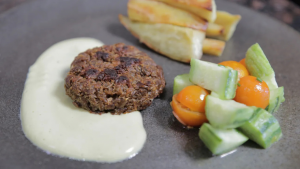From the Series

Sumien Brink is the award-winning editorial director of design publication Visi and food magazine Taste. She cooks, bakes and gardens too.
Can you design food culture? What would you include?
Maybe in the beginning stages of a person’s life, but you cannot design the way a family teaches their children to eat; each family is different, with a different culture and heratige. At primary school level, a good food system should be in place, but it shouldn’t show kids how they should eat, but rather what is in everything they eat. Everyone must make their own choices, but hopefully in the future no one will be able to say "I didn't know deep-frying everything is bad!"
What's the biggest problem with the current food system?
The fact that we’re so removed from the production of the food we eat. If we knew how food is being produced, most of us would change our ways pretty quickly. These foods will have a negative effect on our children and I'm sure the people of the future will suffer weaker immune systems, more cancer and die earlier because of the limited diet we eat, which is mostly genetically modified, pesticide-drenched food.
Why do we eat shrimps but not insects?
I know, it’s silly! It's partly a cultural thing; I once spoke to some Damara men (a Namibian tribe) who could not understand why we would want to eat these ugly things – they look like cockroaches! Maybe we see them as "clean" because they pickle around in salt water all day, while cockroaches hang around in sewers?
How can emerging economies’ increasing desire for milk and meat be redesigned?
There could be tax reductions for families who own livestock that graze in communal parks. If a family is closely involved in their future dinners’ lives, maybe they would think twice about eating meat or milk from an animal they did not know.
What’s right with mass production?
It should be that more food equals more people getting food, but it’s not, so there’s nothing right with it.
Is foodie-ism gluttony dressed up as ethical sophistication?
Sometimes, but mostly the foodie movement has helped to create awareness and support for local producers, better quality and health.
Is the purpose of eating design only to manage your weight and biological health concerns?
No, I believe food is meant to be shared and experienced together. My family eats around a table every night, we make food together, and talk about the successes or failures of the night’s dishes. I think you should always keep the food groups in mind when preparing a meal, but if we eat a bit to much starch tonight, we should eat more fresh salads tomorrow night. People should stop worrying about calories and weight, and rather focus on quality of life.
How can designers feed the world?
By giving children and communities the tools and knowledge to feed themselves. Designing systems that work, not in First World countries, but in war-torn, starving and devastated Third World countries.







